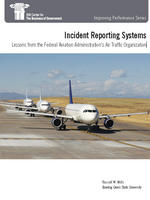
Incident Reporting Systems: Lessons from the Federal Aviation Administration’s Air Traffic Organization

Incident reporting systems are an integral part of many agencies’ operations. For example, the Veterans Health Administration collects data on incidences of errors made during surgeries, the Food Safety and Inspection Service collects data on incidences of errors in meat inspection plants, and the Occupational Health and Safety Administration collects data on incidences of workplace injuries.
But collecting the raw numbers of when an incident occurs does not necessarily help prevent future incidents from happening. Agency managers need to analyze operational data at a much finer level to understand why incidents occur and what can be done to prevent them in the future. This is often called the “black box” of performance management—understanding the relationships that connect potential changes in operations to the needed improvements in outputs and outcomes being measured.
In this report, Dr. Mills offers a case study of the Federal Aviation Administration’s Air Traffic Organization (ATO) incident reporting systems that have evolved since the late 1990s. He describes the introduction of voluntary self-reporting of errors by air traffic controllers and the use of increasingly sophisticated electronic tracking equipment. He writes that, ironically, this better data collection initially alarmed external stakeholders—the traveling public and Congress. To them, it seemed that there was a dramatic increase in the number of operational errors. In fact, the increased reporting of incidents that had previously been undetected or unreported led to a greater understanding of trends and causal factors, thereby allowing ATO to put in place corrective actions. While this led to a safer air traffic system, it created political problems for the agency.
Dr. Mills reports that ATO overcame these political problems by creating a new risk-based reporting system for the traveling public and Congress that demonstrated that the new elements of its incident reporting systems are contributing to greater safety. Based on the experience of ATO’s evolving incident report systems, Dr. Mills offers a set of strategic, management, and analytical lessons that could be applied by other agencies that may also be in the process of increasing the sophistication of their own incident reporting systems.



